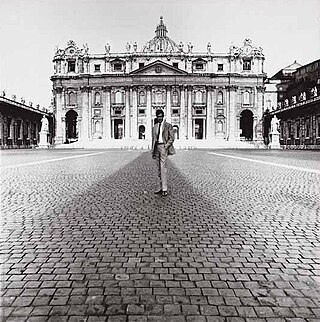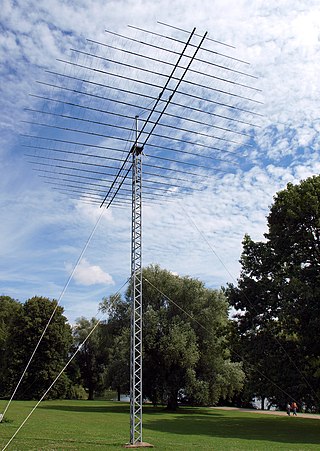
Erfurt (German pronunciation:[ˈɛʁfʊʁt] ) is the capital and largest city of the Central German state of Thuringia. It lies in the wide valley of the River Gera, in the southern part of the Thuringian Basin, north of the Thuringian Forest, and in the middle of a line of the six largest Thuringian cities, stretching from Eisenach in the west, via Gotha, Erfurt, Weimar and Jena, to Gera in the east, close to the geographic centre of Germany. Erfurt is 100 km (62 mi) south-west of Leipzig, 250 km (155 mi) north-east of Frankfurt, 300 km (186 mi) south-west of Berlin and 400 km (249 mi) north of Munich.

Boniface was an English Benedictine monk and leading figure in the Anglo-Saxon mission to the Germanic parts of Francia during the eighth century. He organised significant foundations of the church in Germany and was made bishop of Mainz by Pope Gregory III. He was martyred in Frisia in 754, along with 52 others, and his remains were returned to Fulda, where they rest in a sarcophagus which remains a site of Christian pilgrimage.

Joseph Heinrich Beuys was a German artist, teacher, performance artist, and art theorist whose work reflected concepts of humanism, sociology, and, with Heinrich Böll, Johannes Stüttgen, Caroline Tisdall, Robert McDowell, and Enrico Wolleb, created the Free International University for Creativity & Interdisciplinary Research (FIU). He previously in his talks and performances also formed The Party for Animals and The Organisation for Direct Democracy. He was a member of a Dadaist art movement Fluxus and singularly inspirational in developing of Performance Art, called Kunst Aktionen, alongside Wiener Aktionismus that Allan Kaprow and Carolee Schneemann termed Art Happenings. Today, internationally, the largest performance art group is BBeyond in Belfast, led by Alastair MacLennan who knew Beuys and like many adapts Beuys's ethos.

Donar's Oak was a sacred tree of the Germanic pagans located in an unclear location around what is now the region of Hesse, Germany. According to the 8th century Vita Bonifatii auctore Willibaldo, the Anglo-Saxon missionary Saint Boniface and his retinue cut down the tree earlier in the same century. Wood from the oak was then reportedly used to build a church at the site dedicated to Saint Peter. Sacred trees and sacred groves were widely venerated by the Germanic peoples.

The Kunstakademie Düsseldorf is the academy of fine arts of the state of North Rhine Westphalia at the city of Düsseldorf, Germany. Notable artists who studied or taught at the academy include Joseph Beuys, Gerhard Richter, Magdalena Jetelová, Gotthard Graubner, Nam June Paik, Nan Hoover, Katharina Fritsch, Tony Cragg, Ruth Rogers-Altmann, Sigmar Polke, Anselm Kiefer, Rosemarie Trockel, Thomas Schütte, Katharina Grosse, Michael Krebber and photographers Thomas Ruff, Thomas Demand, Christopher Williams, Thomas Struth, Andreas Gursky and Candida Höfer. In the stairway of its main entrance are engraved the Words: "Für unsere Studenten nur das Beste".
Michael Buthe was a German artist who lived and worked between Germany and Morocco. He exhibited widely throughout Europe during his life and is known for his eclectic and prolific oeuvre which encompasses painting, sculpture, and installation.

Johann Peter Theodor Janssen was a German historical painter.

Lothar Wolleh was a well-known German photographer.

Skulptur Projekte Münster is an exhibition of sculptures in public places in the city of Münster (Germany). Held every ten years since 1977, the exhibition shows works of invited international artists for free in different locations all over town, thereby confronting art with public places. After every exhibition, the city buys a few of the exhibited sculptures which are then installed permanently.
Heinz Günter Mebusch (1952–2001) was a German photographer and experimental artist born in Düsseldorf.
Von hier aus – Zwei Monate neue deutsche Kunst in Düsseldorf is the title of an art exhibition from 29 September 1984 to 2 December 1984. It was organised by the city of Düsseldorf and the Gesellschaft für aktuelle Kunst Düsseldorf e.V. and was curated by Kasper König.
Social sculpture is a phrase used to describe an expanded concept of art that was invented by the artist and founding member of the German Green Party, Joseph Beuys. Beuys created the term "social sculpture" to embody his understanding of art's potential to transform society. As a work of art, a social sculpture includes human activity that strives to structure and shape society or the environment. The central idea of a social sculptor is an artist who creates structures in society using language, thoughts, actions, and objects.

7000 Oaks – City Forestation Instead of City Administration is a work of land art by the German artist Joseph Beuys. It was first publicly presented in 1982 at documenta 7.
How to Explain Pictures to a Dead Hare is a performance piece staged by the German artist Joseph Beuys on 26 November 1965 at the Galerie Schmela in Düsseldorf. While it was only Beuys’s first solo exhibition in a private gallery, it is sometimes referred to as his best known action.
Jörg Rüpke is a German scholar of comparative religion and classical philology, recipient of the Gay-Lussac Humboldt Prize in 2008, and of the Advanced Grant of the European Research Council in 2011. In January 2012, Rüpke was appointed by German Federal President Christian Wulff to the German Council of Science and Humanities.

Anatol Herzfeld was a German sculptor and mixed-media artist, and also a policeman. A student of Joseph Beuys, he primarily used wood, iron and stone as materials. As an artist, he simply signed Anatol. He received attention for a happening, crossing the Rhine in a boat he created with Beuys, after Beuys had been expelled from the Kunstakademie Düsseldorf.

Paul Maximilian Heinrich Schneider von Esleben, known as Paul Schneider-Esleben, was a German architect who worked in the modernist movement, mostly on airports, throughout the 1960s.

Johannes Hill is a German baritone in concert and in oratorios, who has performed internationally. Singing in choirs from age 10, he has performed major roles in oratorios, such as both Jesus and Pilate in Bach's Passions, and Pope Francis in the premiere of Laudato si'. He has also performed in vocal ensembles such as Kammerchor Stuttgart and Collegium Vocale Gent.

Wächter is a series of large outdoor iron sculptures by Anatol Herzfeld, a student of Joseph Beuys who was both a traffic policeman and an artist, with a recurring theme. The sculptures are located at various places in Germany. One of them watches over a positive change in the environment, another is a monument to policemen killed in the line of duty.

Heinrich Nauen was a German Expressionist artist. He created oils, watercolors, and prints; as well as murals and mosaics. A large part of his output consists of landscapes and floral still-lifes.














